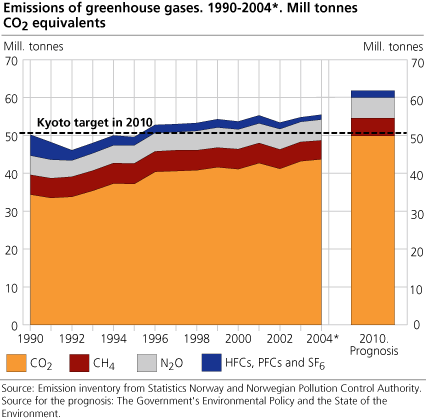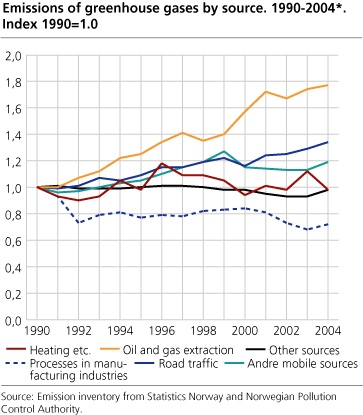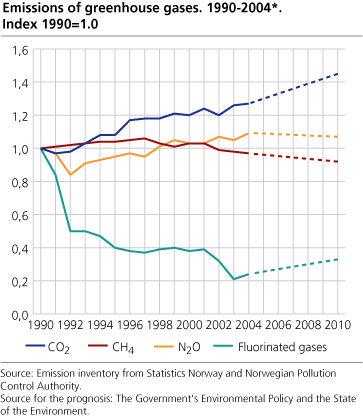Content
Published:
This is an archived release.
Greenhouse gas emissions continue to rise
The emission of greenhouse gases continues to rise in Norway. Since 1990, such emissions have increased by 11 per cent, and from 2003 to 2004 the increase was 1 per cent. CO2 emissions from oil and gas production and road traffic account for the majority of the increase.
These are some of the findings of new preliminary figures from Statistics Norway and the Norwegian Pollution Control Authority.
The overall rise in greenhouse gas emissions since 1990, the base year of the Kyoto Protocol, is 11 per cent. In 2004, the emissions rose by 1 per cent to 55.5 million tonnes CO2 equivalents.
Greenhouse gases include carbon dioxide (CO2), methane (CH4), nitrous oxide (N2O), hydrofluorocarbons (HFCs), perfluorocarbons (PFCs) and sulphur hexafluoride (SF6). In 2004, CO2 emissions accounted for almost 80 per cent of Norwegian greenhouse gas emissions and resulted in an increase in emissions. Since 1990, the CO2 emissions have increased by 27 per cent, while total emissions of HFCs, PFCs and SF6 have fallen by more than 75 per cent. The emission of CO2 is mainly regulated through the CO2 tax and, as of 1 January 2005, the recently established domestic emissions trading scheme for Norway.
Sources of emissions and policy instruments
The rise in CO2 emissions from 1990 to 2004 has to a large extent been caused by emissions from the oil and gas activity (+ 86 per cent). In the same period, emissions from road traffic rose by 26 per cent as a result of increased economic activity. In 2004, emissions from both sources increased. Emissions from the oil and gas activity and road traffic are subject to a CO2 tax on the use of petroleum products (gas, petrol, diesel, etc.). The cause of the increased emissions from oil and gas activities last year was increased gas production, which resulted in increased demand for power.
In 2004, process emissions of CO2 from the manufacturing industry increased. These emissions are heavily dependent on international market trends, and 2004 was a good year for some parts of the process industry. In 2004, a voluntary arrangement between the process industry (the Federation of Norwegian Process Industries) and the Ministry of Environment containing emission targets to be achieved by 2007 was established.
In 2004, CO2 emissions from stationary combustion of oil and gas for heating purposes dropped. This was most probably caused by higher winter temperatures, lower electricity prices and higher oil prices compared with 2003. The use of oil for heating purposes is subject to a CO2 tax.
As pointed out earlier, the total emissions of gases containing fluorides (HFCs, PFCs and SF6) have fallen substantially since 1990. Emissions of such gases are regulated by taxes, a reimbursement system (HFCs and PFCs) and voluntary arrangements with the aluminium industry (PFCs) and the Norwegian Electricity Industry Association (SF6). The reduced emissions of SF6 are also attributable to technological improvements and the closure of a production plant for primary magnesium in 2002.
Above target
According to the Kyoto Protocol, which entered into force on 16 February this year, Norwegian greenhouse gas emissions may be 1 per cent higher than the 1990 level in the period 2008-2012 after emissions trading and other mechanisms for reducing emissions have been taken into account. This is equivalent to an emission level of 50.6 million tonnes CO2 equivalents. In 2004, Norway's aggregated greenhouse gas emissions were 55.5 million tonnes CO2 equivalents. This is 4.8 million tonnes CO2 equivalents or nearly 10 per cent above target. It has been estimated that Norwegian CO2 emissions will increase to about 62 million tonnes CO2 equivalents by 2010 if no new regulatory instruments are introduced. The oil and gas activity and the transport sectors will account for a considerable part of the projected increase.
See also
NOx emissions stable, but reductions needed
Greenhouse gas emissions in Oslo up 9 per cent
National accounts and the environment
See also State of the Environment Norway
More emission figures in StatBank .
Tables:
This page has been discontinued, see Emissions to air, Annually.
Contact
-
Trude Melby Bothner
E-mail: trude.melby.bothner@ssb.no
tel.: (+47) 40 81 14 25
-
Berit Storbråten
E-mail: berit.storbraten@ssb.no
tel.: (+47) 40 81 14 23



